April 2010
Mirage 2000C, Grumman Gosling, AEC Regent Bus.
![]()
Links
to related pages on this Website: ![]()
![]()
![]()
![]() This
Month's significant WW2 70th Anniversaries:
This
Month's significant WW2 70th Anniversaries:
9 Apr - Germany invades Denmark & Norway (Operation Weserübung), ostensibly to protect both countries against Anglo-French occupation.
Danish forces undertake a fierce and well planned defence of their homeland, particularly around the royal palace. After six hours of fighting, and with an explicit threat from the Luftwaffe to destroy Copenhagen, King Christian X reluctantly accepts the inevitable and orders his forces to stop fighting.
The large German force finds Norway a more difficult target, with an equally well planned defence, including the spectacular sinking of the German Cruiser Blucher by the medieval fortress of Oscarsborg in Oslofjord. This sinking of the lead invasion ship delays the German advance, allowing the Royal Family, Cabinet and Parliament to evacuate to evacuate the capital.
Parliament reconvenes in the small town of Elverum, and at the urging of King Haakon, it rejects Nazi demands for surrender, then passes a motion transferring all executive authority to the cabinet until further notice, thereby ensuring that the Norwegian Quisling puppet government can never attain legitimacy.
Norway never surrenders to Germany; Norwegian forces, at home and abroad, continue active operations with their allies against Nazi Germany, until victory on the 8th May 1945.
11 Apr - Under Luftwaffe bombardment, HMS GLASGOW evacuates the Norwegian Royal Family and Cabinet to Tromso.
12 Apr - British Forces peacefully occupy the Faroe Islands in response to the fall of Denmark.
The bitter Allied Norwegian Campaign begins, with French & British units arriving in force to support the Royal Norwegian forces.
Lothians & Borders War Diary
|
|
11 Apr - 1st Lothians & Borders Yeomanry are placed at 2hrs notice to move to the Belgian Frontier 13 Apr - Regiment ordered to move to Marchiennes. 18 Apr - Operational Command unexpectedly transferrred to the 51st Highland Division under Major General Fortune and the regiment is ordered to move to the Saar front at the northern end of the Maginot Line, where it will operate under French command. 29 Apr - Regimental move complete. 30 Apr - During a border skirmish with German forces on the Ligne de Contact, the Lothians' Vickers Mk VIb tanks (A Sqn, Maj Dallmeyer) become the first British Cavalry Regiment to see action in WW2. First in action, the Lothians would soon also become the last British Cavalry Regiment to see action during the battle for France. |
Dassault Mirage 2000c, Escadron de Chasse 1/5 "Vendee", Armee de l'Air, Orange-Caritat AB, 1989.
Airfix 1/72
I definitely have a soft spot for Mirages - who doesn't ?
This is the Airfix/Heller issue from the 1990s and is very typical of the output during that difficult period; whilst it is well moulded and well engineered, it has rather heavily raised panel lines, was clearly designed to a limited budget and is moulded in horrible soft bendy plastic.
It also has a disappointingly plain set of markings, for the French & Hellenic Air Forces. As might have been expected, one of the colours (the yellow) was badly out of register, although I think I can live with them.
However, despite these shortfalls, it's not a bad rpresentation of the final evoloution of the 50 year old Mirage family.
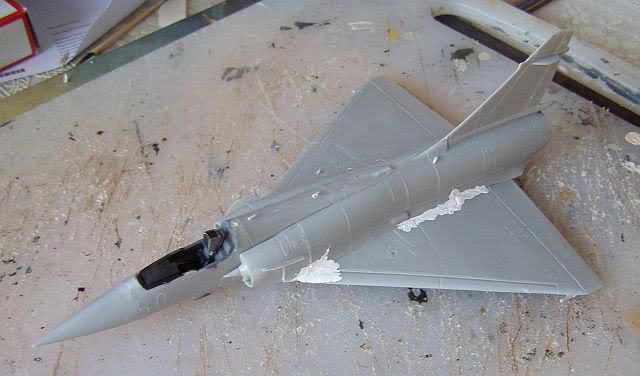
As with most Mirage kits, assembly is pretty straightforward. The long wing/fuselage join on each side, and the front wing/fuselage join both need a little filler. There are also some very thin antennae moulded into one fuselage half, but which will almost certainly not survive my tidying up the fuselage seams. My kit had a badly warped fuselage and a bent fin - possibly due to bad storage, but fairly easy to fix with clamps and glue.
The rather fussily angled Mirage undercarriage defeated me slightly - the nose wheel strut should be angled backward and the main wheel struts angled inward. I managed the former but not the latter.
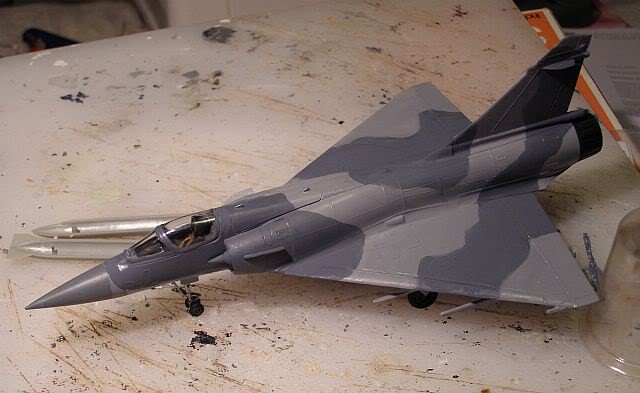
The weathering looks much heavier in the photo than it does in real life, and some matt varnish will tone it down even further.

I can't decide whether to mark it up as the more colourful French aircraft, or the rather plain Greek option provided in the box. I think, but can't be absolutely sure, that I had the pleasure of being "buzzed" by a Greek one of these in the Aegean sea back in the mid 1990s, so the Greek option is looking good. But the French one looks marginally more colourful. Decsions, decisions.
French it is. Decals applied without issues and a top coat of Matt varnish completes the build. I have done the missiles too, and I guess I will add them in due course!
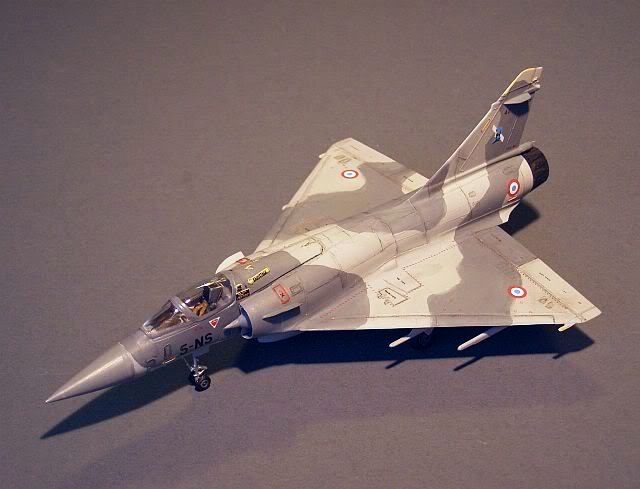
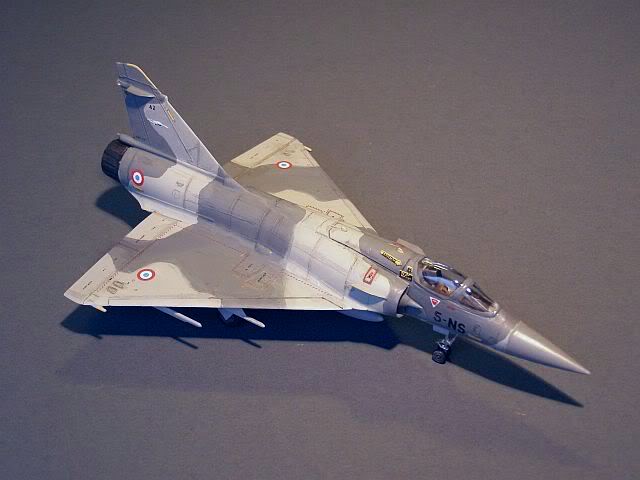
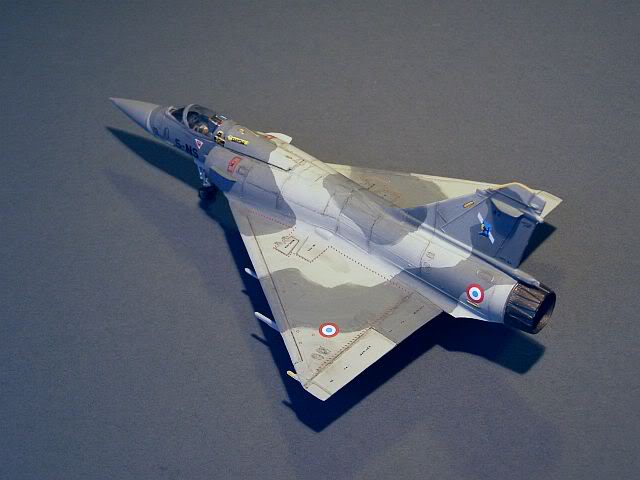
All in all, a satisfying and straightforward quick build, that adds another flavour of Mirage to my collection!
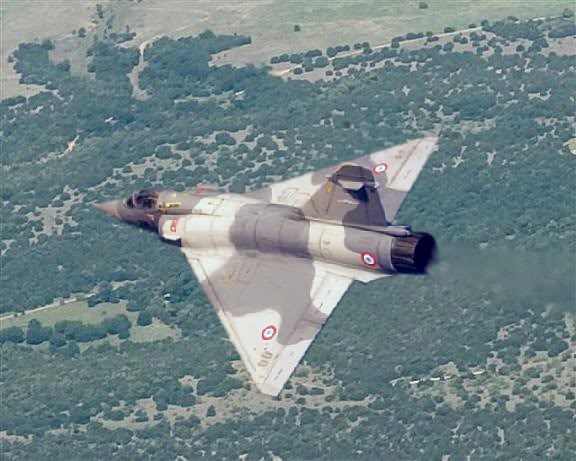
Grumman J4F-1 Gosling, Fleet Air Arm, West Indies, 1944.
Airfix 1/72
This is another ancient, but much sought after kit (first issued in 1958), that has been re-released by Airfix in 2010 under its new Hornby ownership. Several Goslings (known as the Widgeon in US service) were used by the Royal Navy in the West Indies and US as communications aircraft.
The kit itself is really rather crude - not particularly well fitting, with little detail and some misshapen smaller parts. This is another Indian moulded issue, and it is good to see that it continues the run of minimal flash and soft maleable plastic, with very clear transparencies nicely packed in a separate bag. However, it will definitely require some filler, particularly around the engines and floats.
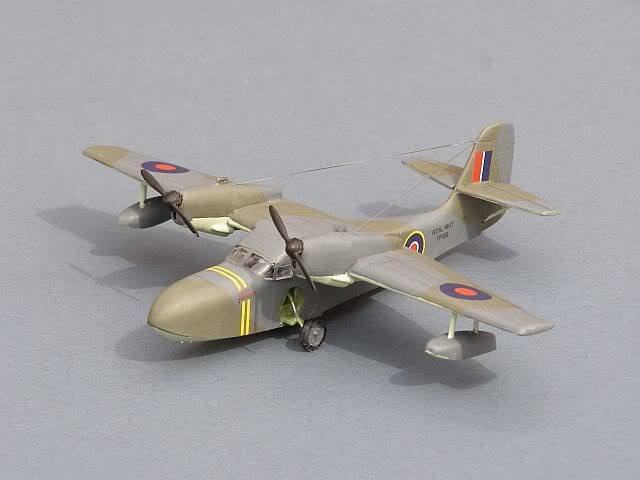
Where this latest issue excels though (over and above the superb box and box-art), is in its decals/transfers. These are really quite superb and are clearly produced by one of the better after-market producers. Well done Airfix! I have a 1980 issue of this kit and there is really no comparison.
Options are for machines of either the Royal Navy or the US Coast Guard.
OK, so its old and basic, but the decals and packaging are encouraging signs of the standard that Airfix hopes to achieve in the future.
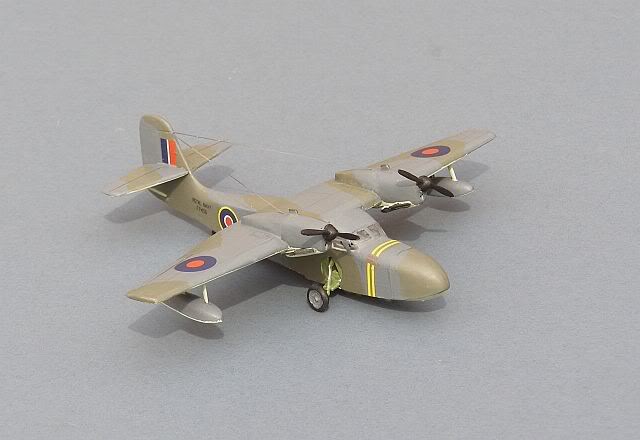
Many more WW2 Royal Navy Aircraft on the RN Props Pages
Edinburgh Coporation Bus, AEC Regent III, 1950.
Tower Models 1/76
To finish the month, another departure into self-indugence and something completely different. This is the Tower Models London RTL bus, modified slightly to become an Edinburgh bus from the early 1950s. I guess that buses are a peculiarly British form of modelling, but I have never done one before.

The build begins. The horrible green plastic is apparently because this is intended to be a London Coutry Bus, in a deep dark green colour?
Tower Models produced a wide range of 1/76 buses which can be difficult to find nowadays. They are a bit chunky, but the level of detail is adequate for the scale, and I really had a lot of fun building it.
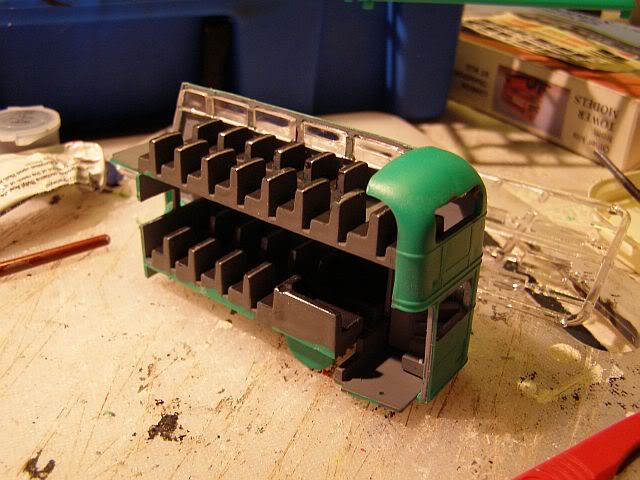
Seats and innards painted and assembled

As supplied, the kit builds a London Country RTL, based on a Leyland Titan Chassis and with a Metro Cammel body. The RT series was originally designed in the late 1930s by AEC, the engineering division of London Transport. In the immediate post-war period, it finally reached volume production, as the RT for London Transport and the Regent for the regions. With AEC at full capacity, Leyland were contracted to build almost identical buses, based on their rather older (1927) Titan chassis and to be known as the RTL. The last RT bus left regular service with London Transport in 1979 after 40 years of continuous service.
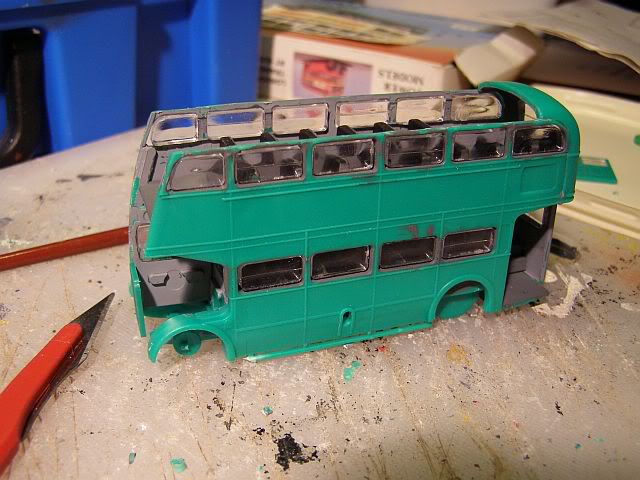
Other side attached
AEC Regent buses, carrying the same Metro Cammel body as the kit's , were used in comparatively small numbers by Edinburgh Corporation (most Edinburgh buses at that time were either Guy Arabs, Daimlers or the Leyland PD2/PD3 Titan, which is also very similar to an RTL, but has a large "tin front" grillle). Tower Models suggest that the AEC RT bus has a different radiator from the Leyland RTL, and provide a more ornate one as an aternative. However, the only picture I can find of an Edinburgh Regent has a plain radiator, so that is what I will stick with!

And then the roof
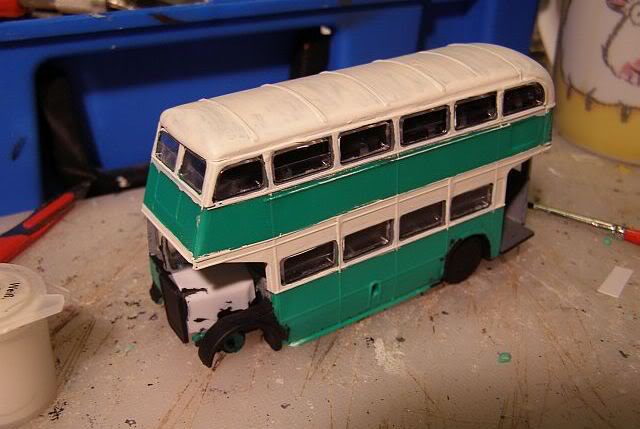
White paint applied. The bonnet part was missing from my (sealed) kit, so I have made up a replacement from plastic card
I guess the real bus enthusiasts will squirm at my conversion, but "am I bovered?" I'm just old enough to remember when open door buses were the norm, and I always remember being terrified of clambering down the stairs and standing on the platform as the bus was moving, but equally well enjoyed sitting on the front seat and watching the driver in his goldfish bowl as he worked. One thing I don't remember though was what they were like in winter - but I can imagine that they must have been freezing inside!
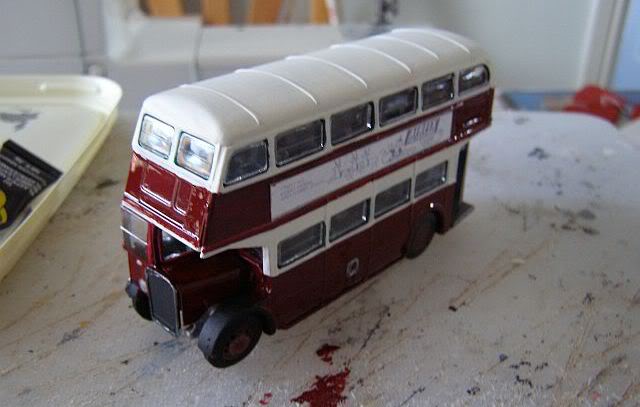
Edinburgh red
applied - apparently the correct name for this colour is
"Madder", although as a
life-long Hearts
supporter, I consider it to be Maroon. Jam Tarts rule!
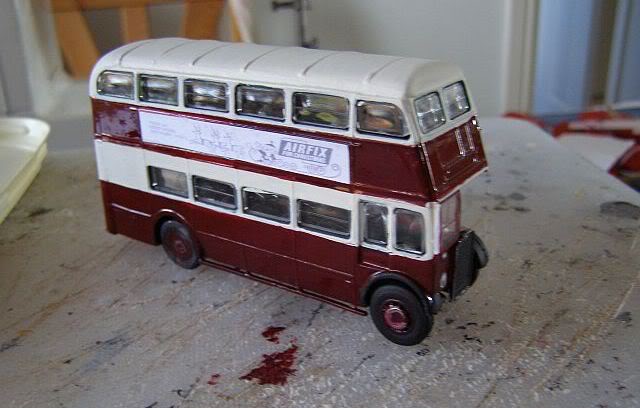
Nearly finished- some tidying up and top-coat varnish to complete.
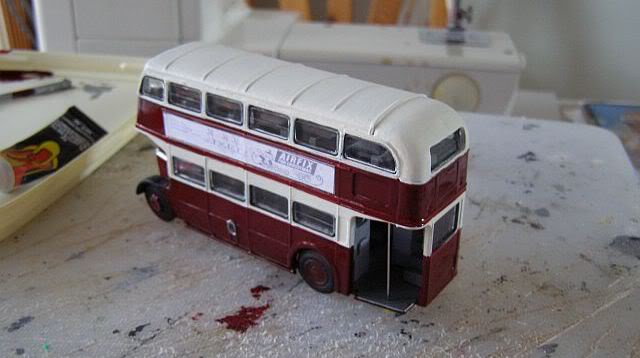
And the finished article, photographed in between the rain showers. The side advert banners are scanned from a Christmas 1959 Airfix advert in an old modelling magazine!
Rather different from my usual modelling subjects, but still fun!:
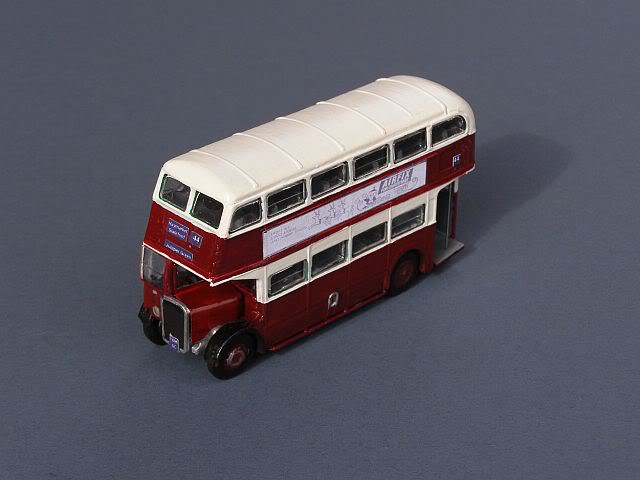
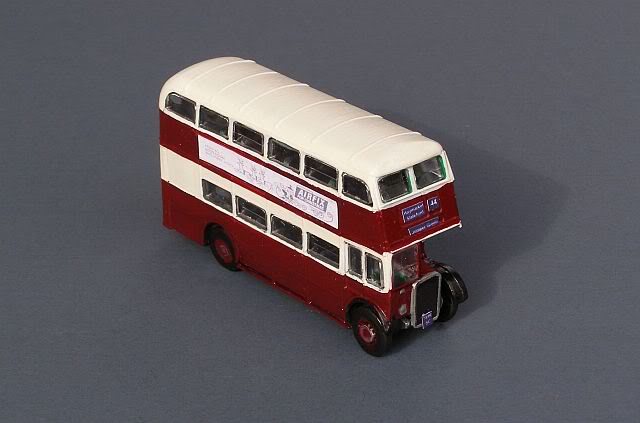

More vehicles and other models on the Dark Side Pages
Links
to related pages on this Website: ![]()
![]()
![]()
www.gengriz.co.uk